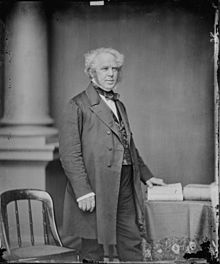William Boeing was born in Detroit, Michigan, to Marie M. Ortmann, from Vienna, Austria, and Wilhelm Böing (1846–1890) from Hohenlimburg, Germany.[1] Wilhelm Böing emigrated to the United States in 1868 and initially worked as a laborer.[2] His move to America was disliked by his father and he received no financial support. He later made a fortune from North Woods timber lands and iron ore mineral rights on the Mesabi Range of Minnesota, north of Lake Superior.[1]
In 1890, when William was eight, his father died of influenza, and his mother soon remarried.[2] He attended school in Europe at Vevey, Switzerland, and returned to the U.S. for a year of prep school in Boston.[2] He enrolled at Yale University in New Haven, Connecticut.[3] He left Yale in 1903 before graduating to go into the lumber business.
Career[edit]
Boeing moved to the Pacific Northwest at Hoquiam, Washington. He purchased extensive timberlands around Grays Harbor on the Olympic Peninsula, and also bought into lumber operations. He made a success of the venture, in part by shipping lumber to the East Coast via the new Panama Canal, generating funds that he would later apply to a very different business.[4]
While president of Greenwood Timber Company, Boeing, who had experimented with boat design, traveled to Seattle, where, during the Alaska-Yukon-Pacific Exposition in 1909, he saw a manned flying machine for the first time and became fascinated with aircraft. Boeing decided to take lessons at the Glenn L. Martin Flying School in Los Angeles and he purchased one of Martin's planes.[5] Martin pilot James Floyd Smith traveled to Seattle to assemble Boeing's new Martin TA hydroaeroplane and continue to teach its owner to fly. Huge crates arrived by train, and Smith assembled the plane in a tent hangar erected on the shore of Lake Union. William Boeing became a pilot. Boeing's test pilot, Herb Munter, soon damaged the plane. When he was told by Martin that replacement parts would not become available for months, Boeing told his friend Commander George Conrad Westervelt of the US Navy, "We could build a better plane ourselves and build it faster". Westervelt agreed. They soon built and flew the B & W Seaplane, an amphibian biplane that had outstanding performance. Boeing decided to go into the aircraft business and bought an old boat works on the Duwamish River near Seattle for his factory.
Founding of Boeing Aircraft[edit]
In 1916, Boeing went into business with George Conrad Westervelt as "B & W" and founded the Pacific Aero Products Co. The company's first plane was the Boeing Model 1 (B & W Seaplane). When America entered the First World War on April 8, 1917, a little more than a month later, Boeing changed the name from Pacific Aero Products Co. to Boeing Airplane Company[1] and obtained orders from the U.S. Navy for 50 planes. At the end of the war, Boeing began to concentrate on commercial aircraft. He secured contracts to supply airmail service, and built an airmail operation and later passenger service that evolved into United Airlines.





